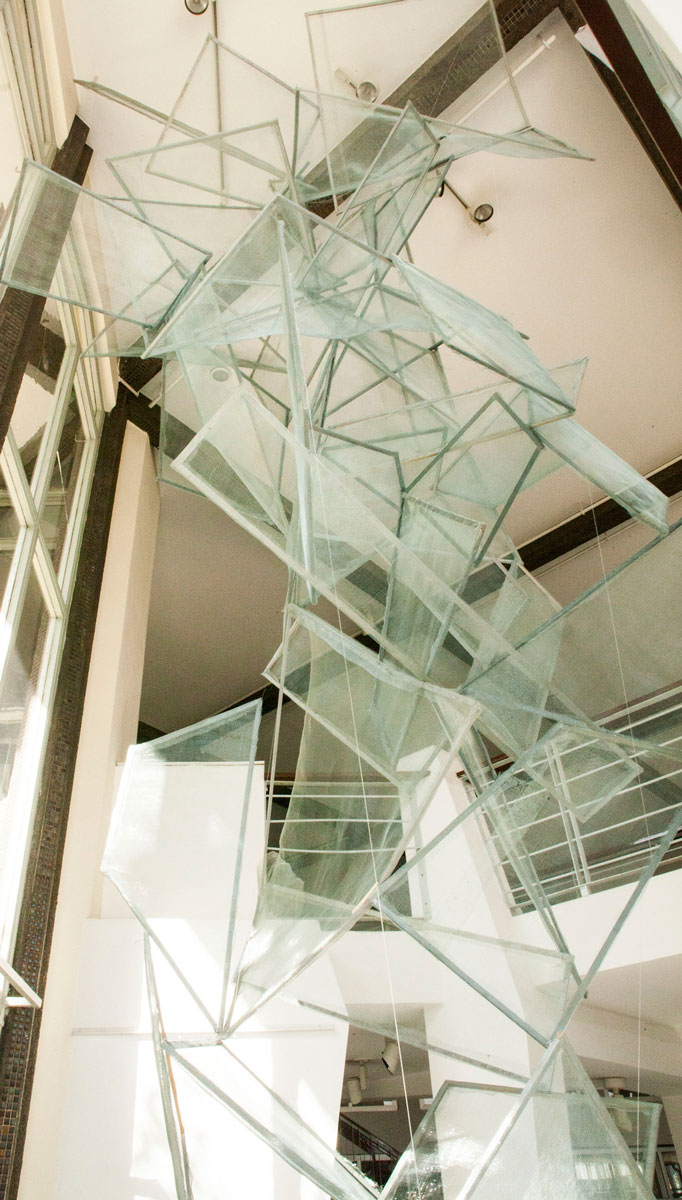
“Khala,” (2013) Glass, metal. approx. 55.1 x 55.1 x 156 inches. Courtesy the artist. Photo: Jawid Taiman.

“Haq Khwastan Jurm Hast (It’s a Crime to Ask for Rights),” (2011). Fiber glass, auto body filler. approx. 7.9 x 67 x 47 inches. Courtesy the artist. Photo: Jawid Taiman

“STOP the Women!,” (2013). Fiberglass, metal, patina. Approx. 31.5 x 27.5 x 78 inches. Courtesy the artist. Photo: Jawid Taiman
[](#)[](#)
Malina Suliman
Step to Me, Fundamentalism
Contemporary artist Malina Suliman’s studies in Realism at the Art Council Karachi of Fine Arts were cut short just shy of her final exam in 2010, when her family summoned her back to Afghanistan. They told her they didn’t want her to continue her art, and grew embarrassed by the mark on her name with each work. Placated by the lie that she could eventually resume to her studies, Malina returned home. She was then kept tucked away, unable to leave her home for nearly a year. As she describes the house arrest over Skype, Suliman is pensive. It’s clear that part of her is still waiting, wanting, and her family may be dismayed to know that their confinement elicited an unintended effect: “Today, whatever I am doing for art, it’s all because of that one year in which I was staying in a home.”
The 23-year-old artist is currently participating in a painting and sculpture exhibition at the French Cultural Center in Kabul. Her graffiti work warrants attention from international media and also, lamentably, the local Taliban. By depicting the injustices of her country, the artist speaks directly to its violators, and her message is clear: “We are not sleeping.”
Her tone falters as I ask about her family’s support in the face of her newly found fame. Malina Suliman’s answer is flat: “They are not that much supporting me.” She alludes to the problems her artwork creates, the limited permissions she is granted, and then speaks six words uncharacteristically uttered publicly by an Afghan woman, “but I fight for my art.”
As the first artist to present an installation—War and Chaos, in the dangerous Kandahar region—Malina chose her subject carefully: depicting the site of a bomb’s explosion and detailing the civilians who were caught in the vicinity of the blast and had to run for their lives. “I didn’t have much expectation, but then I saw that people were crying. They said, ‘We have never seen this art before.’ They said, ‘We’ve never seen this moment.’”
With bombs being flicked across the region like the dying embers of a cigarette, local media has little interest in reporting on the exploits of Afghan artists. This fact leaves Malina restless. “\[The public\] needs to see that artists are also a piece of this country, doing work inside of this war.” When asked how she pictures herself twenty years from now—when the young artist will be in her forties—she does not deliver the casual confidence that change is inevitable, common to many Westerners. “I will be the same as those women who still don’t have rights and still have broken wishes. I see myself with them.” She caveats, “…But, I just have one more portrait of myself; it’s that I’m not keeping myself in silence. That’s different from the others.”
That portrait is on the soot-covered streets where Suliman steps out in search of a clean wall. Clutching a bag and a paper sketch, she braces herself to work. Though her graffiti takes less than three minutes, it is enough time for a crowd of mostly men to construct a half moon around her. Some talk about how they enjoy her work, others curse her effort.
“When my work is finished I put the cans in my bag and I leave that place. Sometimes my friends bring their cars, sometimes I take a taxi, and sometimes I just run. I’m not seeing what’s happening or who’s talking. I’m not seeing what’s behind me. I am just running.”
